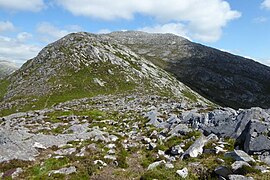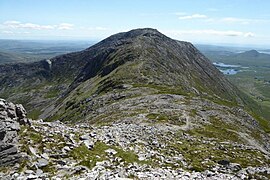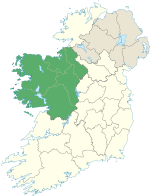Derryclare
Derryclare's prominence of 129 metres (423 ft) does not qualify it as a Marilyn, however, it does rank as the 72nd-highest mountain in Ireland on the MountainViews Online Database, 100 Highest Irish Mountains, where the minimum prominence threshold is 100 metres.
Naming
The name "Derryclare" comes from Irish Doire Chláir; doire means "an oak wood", and clár can mean either a "plain" or a "board/plank-bridge". Irish academic Paul Tempan says Ordnance Survey Ireland most likely transferred the name from the nearby townland of Derryclare, east of the mountain. The full Irish name of the mountain itself is Binn Doire Chláir, meaning "peak of the oak wood at the plain or plank-bridge"; such a translation would be consistent with the easterly slopes of Derryclare, where Derryclare Wood is bounded by Derryclare Lough and Lough Inagh.
On the mountain's southern shoulder is a rocky outcrop called Bennaderreen, from Binn an Doirín, "peak of the little oak wood".
Geography
Derryclare is one of the most southerly of the Bens and sits at the eastern side of the entrance to the large U-shaped valley of the Glencoaghan River. To the south of Derrclare is the scenic lake of Derryclare Lough, and to the east is the large Inagh Valley, and Lough Inagh.
Derryclare's only neighbour is Bencorr 711 metres (2,333 ft), the 2nd-highest peak in the Twelve Bens range, to which it is connected by a high northern rocky ridge. Derryclare and Bencorr form a large deep eastern corrie called Irish: Log an Choire Mhóir (meaning "wood of the big corrie").
The corrie leads down to the Derryclare Wood, which includes a 19-hectare broadleaf forest that is a Statutory Nature Reserve (SRN), and a 789-hectare commercial conifer forest owned and operated by Coillte; both of which are bounded by Derryclare Lough and Lough Inagh.
Derryclare Nature Reserve
In 1980, the Irish state designated 19-hectares of woodland on the eastern slopes of Derryclare as a Statutory Nature Reserve called the Derryclare Nature Reserve (or Derryclare Wood by some sources). The broadleaf trees in the reserve are composed of Sessile Oak, with Rowan (Sorbus aucuparia), Downy Birch (Betula pubescens) and some Ash (Fraxinus excelsior) creating a canopy layer; there are well-developed lichen and fungus flora present. The fungal parasite, Hemigrapha astericus, a native of Australia and South America, was first recorded in the northern hemisphere in Derryclare Wood.
In 2005, 19 Irish red squirrels were translocated from Portumna Forest Park to Derryclare Wood as part of a programme to protect the species in Ireland.
Hill walking
Derryclare is one of the more accessible Twelve Bens, being situated near the N59 road, and a number of routes are available from the Glencoaghan Valley side in the west, or the Derryclare Nature Reserve side in the east, that climb to the summit and back.
Derryclare can be climbed in "horseshoe" walks such as the 11–14 kilometre 5–7 hour circuit of Bencorr (descending via Bencorr's easterly spur at the northern end of Irish: Log an Choire Mhóir), and/or Bencorr North Top (descending via Carrot Ridge, at the northern end of Irish: Log an Choire Bhig).
Derryclare is also often climbed as part of the popular 16–kilometre 8–9 hour Glencoaghan Horseshoe, considered one of Ireland's best hill-walks.
Rock climbing
The large easterly corrie between the summit of Derryclare and the summit of Bencorr, Irish: Log an Choire Mhóir (meaning "wood of the big corrie"), contains several large 200 metre multi-pitch graded rock climbs of grades Diff (D) to Very Diff (VD), the most notable of which is The Knave (VD, 225 m).
Gallery
-
Summit of Derryclare from south-ridge
-
Bencorr (center) and Derryclare (right), from Bencollaghduff
-
Derryclare (left), Bencorr (centre), and Bencorr North Top (right); with the corries of Log an Choire Mhóir (left) and Log an Choire Bhig (right)
-
Looking south to the summit of Derryclare from its northern-ridge with Bencorr
Bibliography
- Fairbairn, Helen (2014). Ireland's Best Walks: A Walking Guide. Collins Press. ISBN 978-1848892118.
- MountainViews Online Database (Simon Stewart) (2013). A Guide to Ireland's Mountain Summits: The Vandeleur-Lynams & the Arderins. Collins Books. ISBN 978-1-84889-164-7.
- Paul Phelan (2011). Connemara & Mayo - A Walking Guide: Mountain, Coastal & Island Walks. Collins Press. ISBN 978-1848891029.
- Dillion, Paddy (2001). Connemara: Collins Rambler's guide. Harper Collins. ISBN 978-0002201216.
- Dillion, Paddy (1993). The Mountains of Ireland: A Guide to Walking the Summits. Cicerone. ISBN 978-1852841102.
See also
- Twelve Bens
- Mweelrea, major range in Killary Harbour
- Maumturks, major range in Connemara
- Lists of mountains in Ireland
- Lists of mountains and hills in the British Isles
- List of Marilyns in the British Isles
- List of Hewitt mountains in England, Wales and Ireland
References
- ^ "Derryclare". MountainViews Online Database. Retrieved 1 August 2019.
- ^ Hendroff, Adrian (2010). From High Places: A Journey Through Ireland's Great Mountains. The History Press Ireland. pp. 13–14.
- ^ Paul Tempan (February 2012). "Irish Hill and Mountain Names" (PDF). MountainViews.ie.
- ^ Simon Stewart (October 2018). "Arderins: Irish mountains of 500+m with a prominence of 30m". MountainViews Online Database.
- ^ Simon Stewart (October 2018). "Vandeleur-Lynams: Irish mountains of 600+m with a prominence of 15m". MountainViews Online Database.
- ^ Mountainviews, (September 2013), "A Guide to Ireland's Mountain Summits: The Vandeleur-Lynams & the Arderins", Collins Books, Cork, ISBN 978-1-84889-164-7
- ^ Dillion, Paddy (2001). Connemara: Collins Rambler's guide. Harper Collins. ISBN 978-0002201216.
- ^ "Site Name: The Twelve Bens/Garraun Complex SAC" (PDF). Department of Culture, Heritage and the Gaeltacht. 2017. Retrieved 29 July 2019.
Site Code: 002031
- ^ "Irish Highest 100: The highest 100 Irish mountains with a prominence of +100m". MountainViews Online Database. September 2018.
- ^ Tim Robinson (2007). Connemara: Listening to the Wind. Penguin. ISBN 978-1844880669.
- ^ Bennaderreen Rock. Placenames Database of Ireland.
- ^ Paul Phelan (2011). Connemara & Mayo - A Walking Guide: Mountain, Coastal & Island Walks. Collins Press. ISBN 978-1848891029.
Route 10: Derryclare and Bencorr
- ^ Catherine Waters; Colin Lawton (2011). Red Squirrel Translocation in Ireland (PDF) (Report). Department of Culture, Heritage and the Gaeltacht. Retrieved 1 August 2019.
- ^ "Derryclare Nature Reserve". Department of Culture, Heritage and the Gaeltacht. Retrieved 1 August 2019.
- ^ "Plan to save red squirrel begins". Irish Times. 5 February 2007. Retrieved 1 August 2019.
- ^ Tony Doherty (30 January 2010). "Ben there and done that". Irish Times. Retrieved 1 August 2019.
- ^ Helen Fairbairn (30 December 2014). Ireland's Best Walks: A Walking Guide (Walking Guides). Collins Press. ISBN 978-1848892118.
ROUTE 34: The Glencoaghan Horseshoe. A true classic
- ^ Dillion, Paddy (2001). Connemara: Collins Rambler's guide. Harper Collins. ISBN 978-0002201216.
Walk 30: Gleann Chóchan Horseshoe
- ^ Tony Doherty (22 June 2016). "A walk for the weekend: The Twelve Bens of Connemara are a hard walk but worth it". Irish Times.
Even if you had to crawl across bogs to get to them, it would be worth it as the nine peaks which form the Glencoaghan Horseshoe provide some of the most exhilarating mountaineering on this island.
- ^ "Inagh Valley: Log an Choire Mhóir". Irish Online Climbing Wiki. Retrieved 1 August 2019.
External links
- MountainViews: The Irish Mountain Website, Bencollaghduff
- MountainViews: Irish Online Mountain Database
- The Database of British and Irish Hills , the largest database of British Isles mountains ("DoBIH")
- Hill Bagging UK & Ireland, the searchable interface for the DoBIH








